Wallingford, Berkshire
Up to 1834
In addition to relief through the parish poor rate, the poor of Wallingford benefited from a number of benefactions and endowments (Hardman, 1994). For example, in 1616 Sir Thomas Bennett of the London Company of Mercers and a native of the parish of Clapcot set up a fund to distribute £20 a year to fifteen elderly poor who were regular church attenders. In 1680, John Angier and his sister Mary bequeathed £870 to the poor of Wallingford of which £200 was used to build almshouses on the Reading Road.
A parliamentary report of 1777 recorded the operation of a workhouse in Wallingford parish of St Mary the More which could accommodate up to 50 inmates.
Eden, in his 1797 survey of the poor in England, reported of Wallingford that:
In 1807, Wallingford parishes of St Mary, St Leonard, and St Peter formed a union under the terms of Gilbert's Act of 1782 and built a workhouse for 282 inmates on the north side of the Wantage Road, about half a mile west of the town centre.
On 23rd May, 1808, the workhouse Guardians appointed Mr James Dehay of South Moreton as surgeon, apothecary and man-midwife for the poor of the union (outside the workhouse as well as inside) at a salary of 30 guineas per annum, which also covered drugs, medical applications and attendances, except for those involving venereal disease.
In March 1818, a meeting of the Guardians laid down the following "Bill of Fare" for the workhouse inmates:
For Breakfast
4 mornings - onion pottage
3 mornings - milk pottage
For Dinner
Sunday - meat and vegetables
Monday - bread and cheese
Tuesday - soup
Wednesday - meat and vegetables
Thursday - suet pudding
Friday - meat and vegetables
Saturday - bread and cheese
In 1828, the parish agreed to employ all able-bodied men applying for work in digging for stone. An area called the "Pit" in the workhouse garden was opened for this purpose, with labourers paid a daily rate of 9d for married men, 6d for single men over fourteen, and 3d for boys; a foreman received 1s.3d. The working day was 8am-4pm with an hour's dinner-break.
Around this time, meetings of the parish vestry (the body responsible for most aspects of parish administration) were held in local pubs such as The Town Arms and The White Hart. Vestry business included setting the rates, caring for the poor, and pursuing the reputed fathers of illegitimate children. For example, in 1830, the vestry applied for warrant for the arrest of Mr John Dalzell who owed arrears to the parish for maintenance of his two bastard children. (The Dalzells were a well-to-do local family.)
With the passing of the Poor Law Amendment Act in 1834, Assistant Poor Law Commissioners began touring the country to implement its proposals, and also reporting on what they found. Richard Hall was clearly not impressed by the state of affairs in Wallingford as his report, published in 1835, makes plain:
A parish workhouse existed at Dorchester from around 1742. It was located at the south-west of the village on the edge of the present allotments which was formerly Hempcroft. The workhouse was initially managed by a woman who in 1755 received the sum of £33.7s.3d. In 1764, the contractor John Wallis was paid 30s. per week, with the parish paying the rent of the house. Wallis was required to maintain all the poor in a decent fashion, except for smallpox cases, those with broken bones, or bastards. He also had to buy three beds and bedding, seven bedheads, and three spinning-wheels. He was not responsible for any expenses relating to resettlement. The parish also paid for hemp seed and the digging of ground rented by the parish. This was probably intended for the paupers to harvest and spin. In 1777, a parliamentary report recorded the Dorchester workhouse as accommodating up to 20 inmates.
After 1834
Wallingford Poor Law Union was formed on 2nd June 1835. Its operation was overseen by an elected Board of Guardians, 29 in number, representing its 29 constituent parishes as listed below (figures in brackets indicate numbers of Guardians if more than one):
Berkshire:
Aston Tirrold, Aston Upthorpe, Brightwell, Cholsey, Didcot, East Hagbourne, Little Wittenham, Long Wittenham, Moulsford, North Moreton, South Moreton, Sotwell, Wallingford Allhallows and Clapcot, Wallingford St Leonard, Wallingford St Mary-le-More,
Wallingford St Peter, West Hagborne.
Later Additions: Clapcot (from 1894), Wallingford Castle Precincts (from 1858)
Oxfordshire:
Benson, Berrick Prior, Berrick Salome, Crowmarsh Gifford, Dorchester,
Ewelme, Mongewell, Newington, Newnham Murren, North Stoke,
South Stoke, Warborough.
The population falling within the union at the 1831 census had been 13,085 with parishes ranging in size from Berrick Prior (population 52) to Wallingford itself (total population 2579). The average annual poor-rate expenditure for the period 1832-35 had been £13,614 or £1.0s.10d. per head of the population.
The existing Gilbert's Union workhouse site on Wantage Road was sold to the new Poor Law Union for £1,450 and the buildings were extended to accommodate up to 382 inmates. The architect for the new buildings was John Plowman of Oxford. The location and layout of the site are shown below on the 1871 map below:
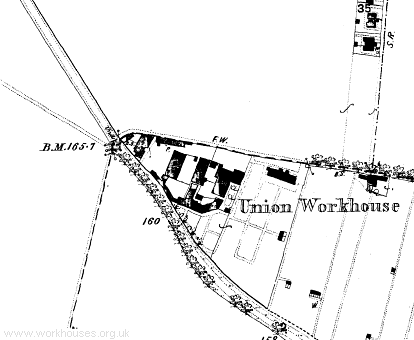
Wallingford workhouse site, 1871.
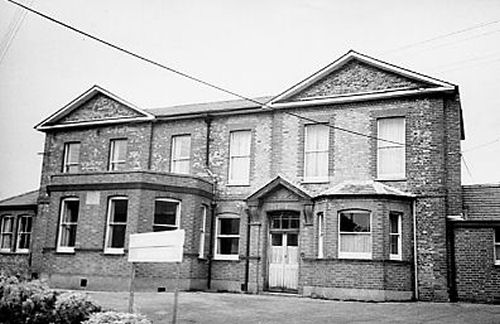
Wallingford entrance block from the south.
© South Oxfordshire District Council.
A fever block was added at the north-east of the site in 1871. A new infirmary, designed by Messrs Charles Smith and Son, of Newbury, was opened at the east of the workhouse on 20 December 1898. At its centre, on the ground floor, were grouped the administrative rooms such surgery, waiting-room, sitting room for Superintendent nurse, stores, kitchen, etc., and on the right hand was the mens' ward for 20 beds, and two separate wards for special cases; each ward had a bathroom, lavatory, and other sanitary accommodation. At the left hand side of the central entrance was similar provision for women. On the first floor, the large and smaller wards had a similar layout to those below and the central group wwas arranged for lying-in patients, with nurses' rooms nearby. The central portion of the building was carried up to a further floor to provide accommodation for the trained nursing staff, which comprised a lady superintendent nurae, one staff nurse and two probationers. The total accommodation of the building was for 46 male and 29 female patients. The new building is shown on the 1912 map below.
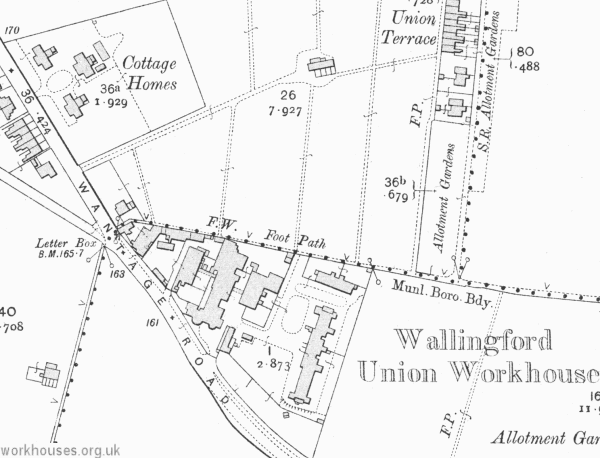
Wallingford workhouse site, 1912.
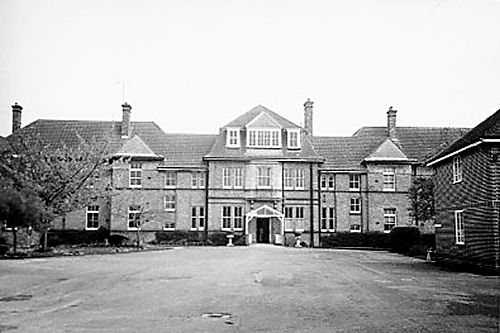
Wallingford infirmary block from the west.
© South Oxfordshire District Council.
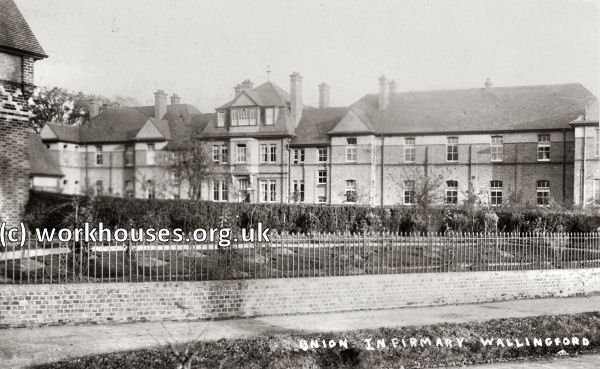
Wallingford infirmary block from the south-west, c.1908.
© Peter Higginbotham.
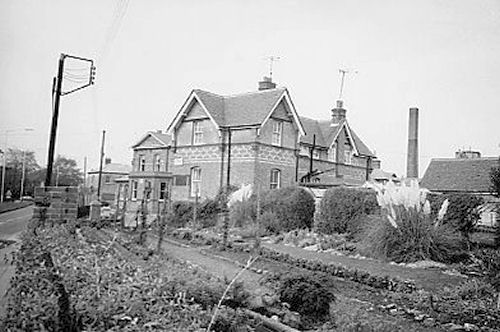
Wallingford site from the south-east.
© South Oxfordshire District Council.
In 1930, the workhouse was renamed Berkshire County Council Institution, then in 1948, with the formation of the National Health Service, it became St Mary's Hospital. In 1966, the old casual block was converted into an orthopaedic clinic.
The hospital finally closed in October 1982 and the site was sold for housing redevelopment to Oxfordshire builders Salthorpe Ltd for £1.75 million. The only part of the old buildings that got a short reprieve was the former dining hall at the north-east of the site, a red-brick building with a slate roof crowned by a ridge lantern.
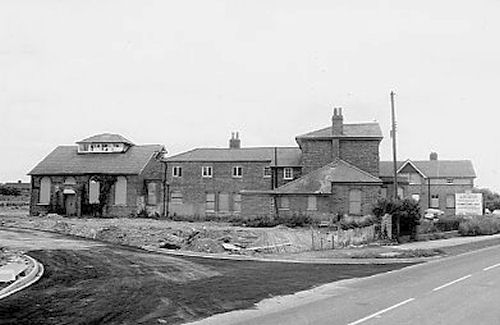
Site Pre-demolition from the east. The dining hall is the building to the left
© South Oxfordshire District Council.
Although the developers were encouraged to preserve the dining hall in some converted form, the building eventually deteriorated to an extent which made this impossible and was demolished. The site is now occupied by a church building which echoes the style of its predecessor. Apparently, a small cellar from the old building remains under the church.
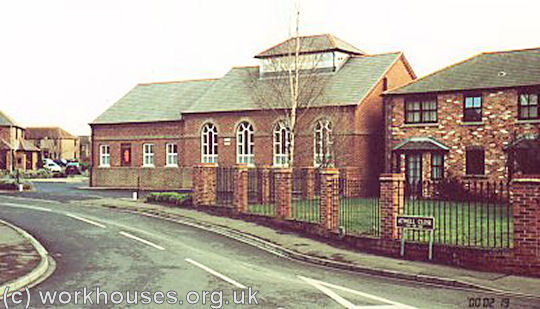
New gospel church, 2000.
© Peter Higginbotham.
Wallingford Cottage Homes
In addition to the workhouse, Wallingford Union operated three cottage homes for the accommodation of 45 pauper children. The homes, designed by Charles Smith and Son, were located on a separate site just to the north-west of the workhouse. The homes were officially opened on 7 April 1900 by Mr. T. W. Russell M.P., Parliamentary Secretary to the Local Government Board. The three buildings were arranged in a triangle, with smaller T-shaped houses set forward of a larger central block. The central building contained accommodation for 15 children and foster mothers. The ground floor included a bay room 15ft. by 18ft., kitchen 15 feet square, scullery, larder, stores, and ablution room. On the first floor was one bedroom for seven beds, and a second bedroom for eight beds, with the mother's room placed between them. A portion of the central block was carried up to third storey, whereas the other blocks had only two storeys. This provided some additional accommodation for sickness or other emergency.
In 1915, infants and girls from the cottage homes were attending the elementary school at Kine Croft. Boys went to the council school on St John's Road.
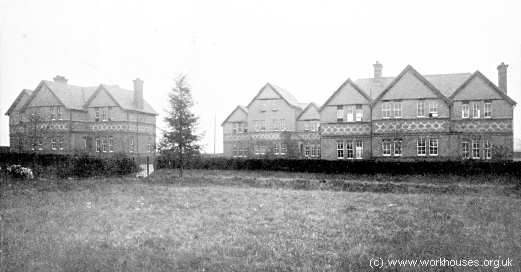
Wallingford Cottage Homes, c.1907.
© Peter Higginbotham.
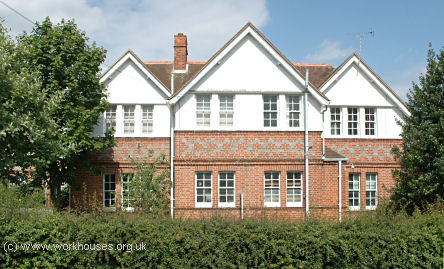
Wallingford Cottage Homes, 2005.
© Peter Higginbotham.
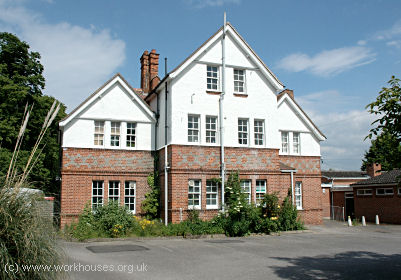
Wallingford Cottage Homes central block, 2005.
© Peter Higginbotham.
Staff
Inmates
Records
Note: many repositories impose a closure period of up to 100 years for records identifying individuals. Before travelling a long distance, always check that the records you want to consult will be available.
- Berkshire Record Office, Berkshire Record Office, 9 Coley Avenue, Reading, Berks RG1 6AF. Records include Guardians' minute books (1835-1930); 1854-1932); Births (1909-45); Deaths (1909-42); Cottage Homes relief lists (1901-24); etc.
Bibliography
- Higginbotham, Peter Workhouses of London and the South East (2019)
- J & S Dewey (1989), Window on Wallingford 1837-1914 Pie Powder Press.
- JS Hardman (1994), Wallingford - A History of an English Market Town
- JK Hedges (1881), A History of Wallingford, Clowes, London
- Victoria County History of Oxford, 1954, OUP.
Links
- Oxfordshire History Centre, St Luke's Church, Temple Road, Cowley, Oxford OX4 2EX.
Unless otherwise indicated, this page () is copyright Peter Higginbotham. Contents may not be reproduced without permission.


